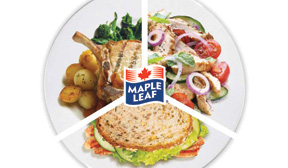 a devastating product recall due to product contamination by Listeria monocytogenes and linked to a meat processing facility outside of Toronto claimed the lives of 23 people in 2008, Maple Leaf Foods has incorporated heightened importance into its food safety program.
a devastating product recall due to product contamination by Listeria monocytogenes and linked to a meat processing facility outside of Toronto claimed the lives of 23 people in 2008, Maple Leaf Foods has incorporated heightened importance into its food safety program.In “Values guided,” the company’s first sustainability report, issued May 17, Maple Leaf said that in the ensuing five years since the recall it has invested millions of dollars and designated significant organizational resources to fulfill a commitment to become a global food safety leader.
“Our goal is to always provide consumers with safe, great-tasting food produced in a safe environment,” Maple Leaf said in the report. “We build food safety into every decision and initiative through a five-prong strategy.”
Prong one of the strategy is to become a global food safety leader. To that end, Maple Leaf has revised its food safety and quality assurance organization to include cross-functional teams, with team leaders reporting independently to the chief food safety officer (Randall Huffman).
“We have made food safety the responsibility of every employee by establishing a tiered food safety training program that covers senior leaders and employees who are involved in food preparation and management,” the company said. “Hourly employees are required to take comprehensive on-floor and on-line training.”
Proactively mitigating risks is the second prong of Maple Leaf’s food safety strategy. The company said it has “significantly enhanced” the manufacturing and testing of its products and sanitation in its plants to proactively identify and eliminate risks.
“Today, every ready-to-eat meat product we make has this method of inhibiting the potential growth of Listeria,” Maple Leaf said. “We continue to focus on prevention through aggressive environmental testing and trend analysis and by monitoring, encouraging and adopting technologies and practices that support this goal. We have placed a priority on building leading food safety practices and engineering into new products and facilities as they are being developed or built.”
Prong three of the approach involves unifying the food safety management system. Every one of Maple Leaf’s 52 food manufacturing facilities that are part of the long-term network adhere to Global Food Safety Initiative (GFSI) standards and are audited every year by the British Retail Consortium audit scheme.
“During 2012, we standardized our food safety internal audit process across our businesses under GFSI requirements and implemented even more stringent requirements and standards,” Maple Leaf said.
Driving supply chain alignment makes up the fourth prong of the strategy, Maple Leaf said. All companies that make products for Maple Leaf must be certified to a GFSI benchmarked protocol and commit in writing to comply with Maple Leaf’s safety and quality standards. Maple Leaf said 94% of its product partners are certified to the standards of the GFSI, and close to 60% of its ingredient suppliers are GFSI certified.
“Although this certification can be challenging for some ingredient manufacturers, we encourage all suppliers to seek certification in accordance with this internationally accepted program,” Maple Leaf said.
The final prong identified by Maple Leaf is to “lead the industry to higher standards.”
“Food safety is not a competitive advantage,” Maple Leaf said. “Any food safety issue, whether caused by Maple Leaf, another manufacturer or a retailer, affects consumer well-being and trust. To advance food safety we have taken a leading role, working with government, academics, retailers and food service companies, and food manufacturers to identify risks and share knowledge and best practices.”
Maple Leaf said it established a Food Safety Advisory Council comprised of five food safety experts from the United States, Canada and the United Kingdom. The council meets three times a year to identify any weaknesses or gaps in the company’s food safety system, provide recommendations and keep the company up-to-date on emerging global issues.
Additionally, during 2012 Maple Leaf hosted its fifth annual Food Safety Symposium. As part of the event, representatives from more than 100 companies and organizations gathered at Maple Leaf’s invitation to discuss the most pressing concerns in food safety.
“Our responsibility does not end when our products leave our plants,” Maple Leaf said. “We work with our customers to ensure safe handling, transportation and storage of our products.”





